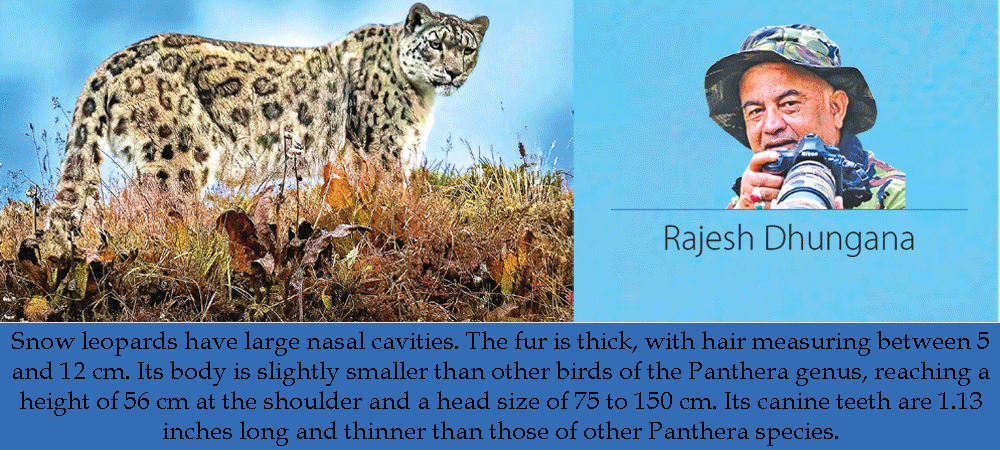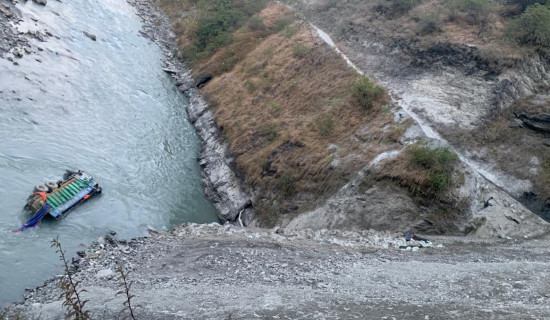- Monday, 1 December 2025
Mountain Ghost: Snow Leopard
The snow leopard is also known as the "mountain ghost." Its body is covered with thick hair and is very strong. The colour of the skin is pale tan, white, or light yellow, while the belly is pure white. Its ears are small and round in shape. Its large paws are covered with fur, which helps protect against snow and even distribute body weight evenly. The long tail of the snow leopard balances the body while hunting and walking. Because its nostrils are big, it can breathe easily even in the thin air of the mountains. A leopard cannot roar, but it can make many different sounds. Its average weight is 22 to 55 kg. The body length of the male snow leopard is 104 to 125 cm, and the female is 87 to 117 cm, while the tail length is 78 to 105 cm.
Apex Predator
The snow leopard (Panthera Unicia) is the apex predator of the Himalayan ecosystem and is found in high mountains in Central and South Asia. The potential habitat of snow leopards in Nepal is estimated at 13,000 square kilometres, with a large number of snow leopards found outside protected areas. The Government of Nepal has adopted a landscape conservation planning approach to protect the snow leopard by delineating the eastern, central, and western landscapes.
These Leopards are found in Nepal, Bhutan, Afghanistan, China, India, Kazakhstan, Kyrgyzstan, Mongolia, Pakistan, the former Russian Federation, Tajikistan, and Uzbekistan. The snow leopard inhabits cold, arid, and semi-arid lands; alpine and subalpine regions; grasslands; and open forests, preferring steep terrain between 3000 and 5500 metres above cliffs, gullies, and cliffs. According to the Snow Leopard Conservation Action Plan 2017–2021, the global population of this species is estimated to be 3921–6290.

According to Dr Ganesh Pant, information officer and ecologist for the National Parks and Wildlife Conservation Department, according to the 2019 annual report, the snow leopard population in Nepal is estimated to be between 300 and 400. According to Dr. Pant, snow leopards are found in Nepal's Annapurna Conservation Area, Kanjanjunga Conservation Area, Langtang National Park, Makalu Varun National Park, Manaslu Conservation Area, Everest National Park, and Phoksundo, while the densest number of snow leopards is found in Dolpa, Humla, as well as in Mugu, Manang, and Myagdi districts
This snow leopard is also called Ounce. Felis Uncia was the scientific name used by Johann Christian Daniel von Schreber in 1777. who described the snow leopard based on an earlier description by Georges-Louis Leclerc, Comte de Buffon. It is believed to have originated on the Barbary Coast of Persia, in eastern India.
The genus name Uncian was proposed by John Edward Gray in 1854 for an Asian cat with a long and thick tail. In 1830, Christian Gottfried Ehrenberg proposed that Felis Ervis was the skin of a female snow leopard collected in the Altai Mountains. He also clarified that many leopard (P. pardus) skins were previously identified as snow leopard skins. Felis uncioides, proposed by Thomas Horsfield in 1855, was a snow leopard skin from Nepal in the East India Company's museum collection.
Snow leopards have large nasal cavities. The fur is thick, with hair measuring between 5 and 12 cm. Its body is slightly smaller than other birds of the Panthera genus, reaching a height of 56 cm at the shoulder and a head size of 75 to 150 cm.
Its canine teeth are 1.13 inches long and thinner than those of other Panthera species. It has a large nasal opening in relation to the length of its skull and the width of its palate. which increases the volume of air to be breathed in with each breath it allows, but at the same time, for warmth and cold dry air humidity, it is not particularly suited to high-altitude hypoxia.
Many Adaptations
These nocturnal animals show many adaptations for living in cold, mountainous climates. Its small, rounded ears help reduce heat loss. Its wide gloves distribute body weight well for walking on snow and have fur on their undersides to increase grip on steep and unstable surfaces. It also helps reduce heat damage.
Among the big cats, the snow leopard is found in the mountainous regions of Asia. It is mainly active at dusk and dawn. A leopard can jump up to 15 metres and can easily hunt animals three times its size. Jharal, Famusa, Thar, Himalayan Blue Sheep (Pseudois Nair), and Himalayan Thar (Hemitragus gemlahicus) are prey. Sometimes it also preys on ibex, musk deer, deer, the Himalayan black bear, and ghoral (a Nepali name).
This snow leopard prefers bottom-weighing mice weighing 36 to 76 kg in particular.Its diet depends on the availability of prey and varies according to its range and season. Snow leopards can hunt prey on cliff faces. They chase animals up to 300 metres using their initial leaping speed. The snow leopard drags the prey to a safe place and consumes all the edible parts of the killed animal. There is no record of snow leopards attacking humans.
The snow leopard mates towards the end of the hound and gives birth between April to July after a gestation period of 90 to 103 days. During mating, it is very active and makes a loud noise to mark its territory.

Snow leopard cubs weigh between 320 and 567 grams at birth. Although the eyes are closed when the cub is born, the skin on the body is still thick. Snow leopard cubs open their eyes at 7 days, can walk at 5 weeks, and become independent at 18 to 22 months. It is fertile within 2 to 3 years and usually lives up to 18 years in its natural habitat, but can live up to 25 years in captivity or in zoos.
Oestrus in snow leopards usually lasts five to eight days, with males not looking for a mate after mating. Perhaps the short mating season does not allow enough time. Paired snow leopards mate 12 to 36 times a day in a typical field posture. Snow leopards usually mate in late winter, after marking and calling. Although the leopard likes to roam alone in a quiet environment, the mother live with cubs.
This animal does not want to be in front of humans. It has its own defined range but does not attack other snow leopards that trespass. It determines its habitat by urinating, defecating, and defecating, with regular walking paths, habitats, and territories. It often lives near rocks, which provide vantage points and shade.
During research in Nepal's Shey Phoksundo National Park, the home ranges of five adult radio-collared leopards overlapped significantly, although they rarely met. Their individual homes range in size from 4.6 to 15.1 square miles. During the study, males and females walked 0.5 to 5.45 km and 0.2 to 2.25 km per day in straight lines between survey points, respectively. In fact, they travel up to 7 kilometres a night, with up to 10 individuals living in an area of 40 square miles.
Endangered
Human settlement and the activities of human communities have caused a great threat to the protection of snow leopards. Hunting for skin and organs to make medicine, excessive hunting by humans, natural food shortages, scarcity of animals, and killing of goods have led to the destruction of habitat due to increases in hunting, population, mining, and urbanisation.
The destruction and fragmentation of habitats, excessive migration, climate change, and weak international cooperation are some of the major challenges in leopard conservation. In Tibet and Mongolia, the skin is used for traditional clothing, and snow leopard kidneys are used to treat human diseases and problems. Meat is used in traditional Tibetan medicine for healing. The bones are used in traditional Chinese and Mongolian medicine to treat rheumatism, leprosy, and human bone and tendon pain.
The snow leopard is listed as endangered on the IUCN Red List. In addition, CITES has been listed as threatened with extinction in Schedule 1 of the Convention on the Conservation of Migratory Species of Wild Animals since 1985.
According to the Nepal National Parks and Wildlife Protection Act, Bikram Sambat 2029, the snow leopard has been listed as a protected species, so that the person who kills or harms it can be fined from 50 thousand to 100,000 rupees or imprisoned for 5 to 15 years, or both.
(All the photos in this article were taken by Chungba Sherpa, a wildlife photographer who hails from Ward No. 3 Chaurikharka, Pasanghamu Rural Municipality, Solukhumbu District (near Tenzing Hillary Airport, Lukla). He managed to take this photo after spending 12 nights sleeping in a tent during a 16-day mission to photograph snow leopards at an altitude of 4,600 metres in Manang, Annapurna Conservation. That's how Chungba was able to take photos of the snow leopard)
(Dhungana is a senior wildlife photographer and writer.)
















